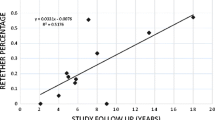Abstract
Object
Lipomyelomeningocele (LMM) is a congenital spinal cord anomaly. While patients with LMM may initially be asymptomatic, neurological sequelae secondary to LMM may become apparent as the patient ages. Consequently, some pediatric neurosurgeons have advocated for upfront neurosurgical interventions irrespective of the presence of symptoms at diagnosis. By contrast, others pursue a conservative approach when overt neurological symptoms are not yet evident. In light of the various practice styles to the heterogeneous anatomical locations, symptoms, and ages associated with LMM, we have conducted a multi-center survey of Canadian pediatric neurosurgeons using clinical vignettes representative of LMM patients.
Methods
An online survey of the opinions of Canadian pediatric neurosurgeons was conducted using 5 separate cases with magnetic resonance imaging (MRI) scans of the lumbar spine. Each case was accompanied with the same three clinical vignettes, which varied in severity at time of presentation: asymptomatic, progressive somatic motor deficit, or longstanding overflow incontinence. Participants were asked the question, “Would you offer surgical management?” after each clinical vignette. After the five cases and their corresponding 3 clinical vignettes, participants were asked, “If you answered yes to any of the preceding questions, what type of surgery would you perform?”. Options for surgical goals and techniques included complete removal, near-total removal, debulking, detethering, and expansile duroplasty. Surgical adjuncts included CUSA, LASER, and neurophysiologic monitoring.
Results
Twenty-three responses were received from the 38 questionnaires sent out to all staff pediatric neurosurgeons across academic medical centers in Canada. This represented a response rate of 61%. Canadian pediatric neurosurgeons generally maintain a conservative approach to the surgical management of LMM as only 13% (n = 3) of surgeons indicated that they would operate in all scenarios. By contrast, 43% (n = 10) indicated surgical management in only those cases presenting with symptoms, and another 43% (n = 10) displayed a variable surgical approach. Nine percent (n = 2) of participants would not perform surgery for incontinence. The greatest level of disagreement among participants pertained to the management of asymptomatic sacral LMM where 43% of participants favored prophylactic surgery, while 57% of participants preferred conservative management.
Conclusions
The current study highlights the differences in management of LMM among Canadian pediatric neurosurgeons and provides further support for future prospective cohort studies to develop appropriate expert opinions and guidelines such that the care of LMM patients may be according to evidence-based best practice. This is especially true for the treatment of asymptomatic patients, a patient group that would benefit from a randomized controlled trial to assess the long-term outcomes of conservative and surgical management.

Similar content being viewed by others
References
Hertzler DA 2nd, DePowell JJ, Stevenson CB, Mangano FT (2010) Tethered cord syndrome: a review of the literature from embryology to adult presentation. Neurosurg Focus 29:E1
Sarris CE, Tomei KL, Carmel PW, Gandhi CD (2012) Lipomyelomeningocele: pathology, treatment, and outcomes. Neurosurg Focus 33:E3
May L, Hayward R, Chakraborty A, Franck L, Manzotti G, Wray J, Thompson D (2013) Lack of uniformity in the clinical assessment of children with lipomyelomeningocele: a review of the literature and recommendations for the future. Childs Nerv Syst 29:961–970
Kanev PM, Bierbrauer KS (1995) Reflections on the natural history of lipomyelomeningocele. Pediatr Neurosurg 22:137–140
Hoffman HJ, Taecholarn C, Hendrick EB, Humphreys RP (1985) Management of lipomyelomeningoceles. Experience at the Hospital for Sick Children, Toronto. J Neurosurg 62:1–8
Sutton LN (1995) Lipomyelomeningocele. Neurosurg Clin N Am 6:325–338
Colak A, Pollack IF, Albright AL (1998) Recurrent tethering: a common long-term problem after lipomyelomeningocele repair. Pediatr Neurosurg 29:184–190
Sakamoto H, Hakuba A, Fujitani K, Nishimura S (1991) Surgical treatment of the retethered spinal cord after repair of lipomyelomeningocele. J Neurosurg 74:709–714
Klein O, Thompson D (2007) Spontaneous regression of lipomyelomeningocele associated with terminal syringomyelia in a child. Case report. J Neurosurg 107:244–247
Talamonti G, D'Aliberti G, Nichelatti M, Debernardi A, Picano M, Redaelli T (2014) Asymptomatic lipomas of the medullary conus: surgical treatment versus conservative management. J Neurosurg Pediatr 14:245–254
Keating MA, Rink RC, Bauer SB, Krarup C, Dyro FM, Winston KR, Shillito J, Fischer EG, Retik AB (1988) Neurourological implications of the changing approach in management of occult spinal lesions. J Urol 140:1299–1301
Kulkarni AV, Pierre-Kahn A, Zerah M (2004) Conservative management of asymptomatic spinal lipomas of the conus. Neurosurgery 54:868–873 discussion 873-865
Wykes V, Desai D, Thompson DN (2012) Asymptomatic lumbosacral lipomas--a natural history study. Childs Nerv Syst 28:1731–1739
Macejko AM, Cheng EY, Yerkes EB, Meyer T, Bowman RM, Kaplan WE (2007) Clinical urological outcomes following primary tethered cord release in children younger than 3 years. J Urol 178:1738–1742 discussion 1742-1733
Cochrane DD, Finley C, Kestle J, Steinbok P (2000) The patterns of late deterioration in patients with transitional lipomyelomeningocele. Eur J Pediatr Surg 10(Suppl 1):13–17
Pang D, Zovickian J, Oviedo A (2009) Long-term outcome of total and near-total resection of spinal cord lipomas and radical reconstruction of the neural placode: part I-surgical technique. Neurosurgery 65:511–528 discussion 528-519
Pang D, Zovickian J, Oviedo A (2010) Long-term outcome of total and near-total resection of spinal cord lipomas and radical reconstruction of the neural placode, part II: outcome analysis and preoperative profiling. Neurosurgery 66:253–272 discussion 272-253
Author information
Authors and Affiliations
Corresponding author
Ethics declarations
Conflict of interest
The authors declare that they have no conflict of interest.
Additional information
Publisher’s note
Springer Nature remains neutral with regard to jurisdictional claims in published maps and institutional affiliations.
Rights and permissions
About this article
Cite this article
Manoranjan, B., Pozdnyakov, A. & Ajani, O. Neurosurgical management of conus lipoma in Canada: a multi-center survey. Childs Nerv Syst 36, 3041–3045 (2020). https://doi.org/10.1007/s00381-020-04641-3
Received:
Accepted:
Published:
Issue Date:
DOI: https://doi.org/10.1007/s00381-020-04641-3




